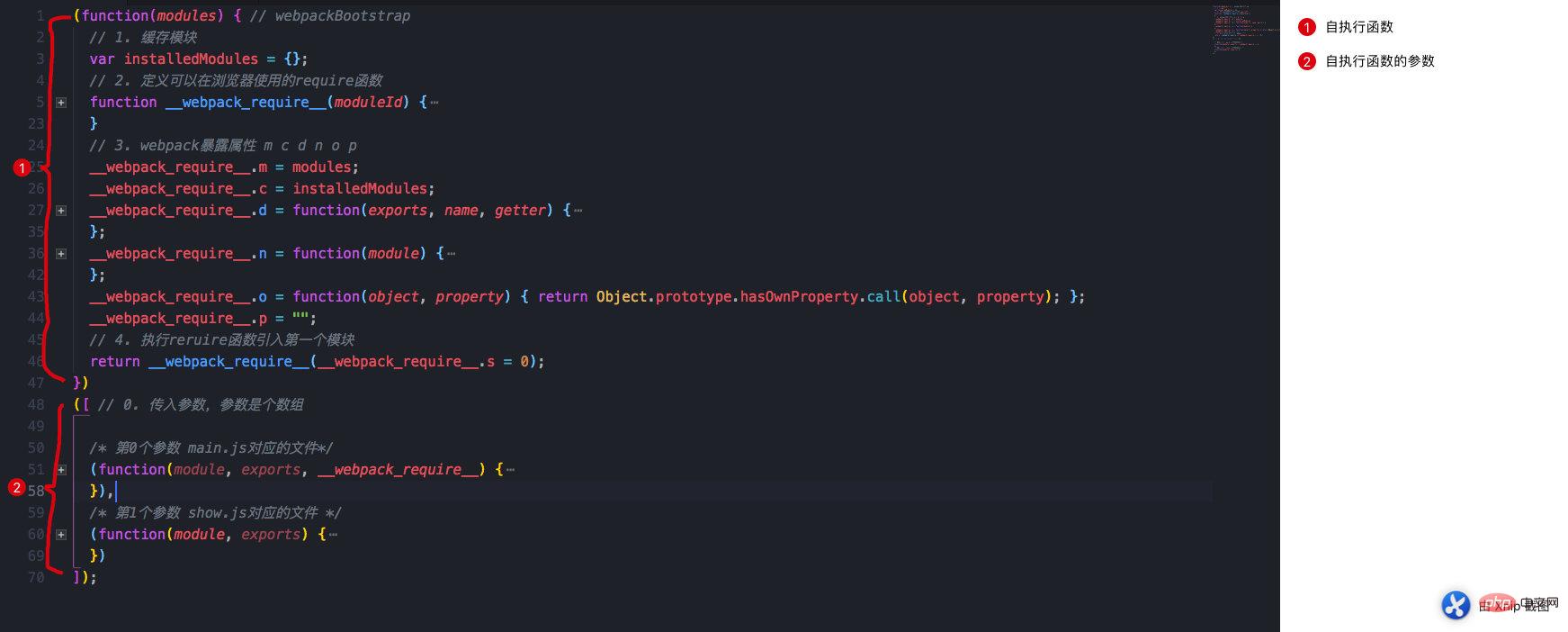실패
| 컴파일 및 출력 중 오류가 발생하여 webpack이 종료되면, 플러그인은 이 이벤트 |
|
에서 특정 오류 원인을 얻을 수 있습니다.在输出阶段已经得到了各个模块经过转化后的结果和其依赖关系,并且将相应的模块组合在一起形成一个个chunk.在输出阶段根据chunk的类型,使用对应的模板生成最终要输出的文件内容. |
//以下代码用来包含webpack运行过程中的每个阶段
//file:webpack.config.js
const path = require('path');
//插件监听事件并执行相应的逻辑
class TestPlugin {
constructor() {
console.log('@plugin constructor');
}
apply(compiler) {
console.log('@plugin apply');
compiler.plugin('environment', (options) => {
console.log('@environment');
});
compiler.plugin('after-environment', (options) => {
console.log('@after-environment');
});
compiler.plugin('entry-option', (options) => {
console.log('@entry-option');
});
compiler.plugin('after-plugins', (options) => {
console.log('@after-plugins');
});
compiler.plugin('after-resolvers', (options) => {
console.log('@after-resolvers');
});
compiler.plugin('before-run', (options, callback) => {
console.log('@before-run');
callback();
});
compiler.plugin('run', (options, callback) => {
console.log('@run');
callback();
});
compiler.plugin('watch-run', (options, callback) => {
console.log('@watch-run');
callback();
});
compiler.plugin('normal-module-factory', (options) => {
console.log('@normal-module-factory');
});
compiler.plugin('context-module-factory', (options) => {
console.log('@context-module-factory');
});
compiler.plugin('before-compile', (options, callback) => {
console.log('@before-compile');
callback();
});
compiler.plugin('compile', (options) => {
console.log('@compile');
});
compiler.plugin('this-compilation', (options) => {
console.log('@this-compilation');
});
compiler.plugin('compilation', (options) => {
console.log('@compilation');
});
compiler.plugin('make', (options, callback) => {
console.log('@make');
callback();
});
compiler.plugin('compilation', (compilation) => {
compilation.plugin('build-module', (options) => {
console.log('@build-module');
});
compilation.plugin('normal-module-loader', (options) => {
console.log('@normal-module-loader');
});
compilation.plugin('program', (options, callback) => {
console.log('@program');
callback();
});
compilation.plugin('seal', (options) => {
console.log('@seal');
});
});
compiler.plugin('after-compile', (options, callback) => {
console.log('@after-compile');
callback();
});
compiler.plugin('should-emit', (options) => {
console.log('@should-emit');
});
compiler.plugin('emit', (options, callback) => {
console.log('@emit');
callback();
});
compiler.plugin('after-emit', (options, callback) => {
console.log('@after-emit');
callback();
});
compiler.plugin('done', (options) => {
console.log('@done');
});
compiler.plugin('failed', (options, callback) => {
console.log('@failed');
callback();
});
compiler.plugin('invalid', (options) => {
console.log('@invalid');
});
}
}
#在目录下执行
webpack
#输出以下内容
@plugin constructor
@plugin apply
@environment
@after-environment
@entry-option
@after-plugins
@after-resolvers
@before-run
@run
@normal-module-factory
@context-module-factory
@before-compile
@compile
@this-compilation
@compilation
@make
@build-module
@normal-module-loader
@build-module
@normal-module-loader
@seal
@after-compile
@should-emit
@emit
@after-emit
@done
Hash: 19ef3b418517e78b5286
Version: webpack 3.11.0
Time: 95ms
Asset Size Chunks Chunk Names
bundle.js 3.03 kB 0 [emitted] main
[0] ./main.js 44 bytes {0} [built]
[1] ./show.js 114 bytes {0} [built]
2 输出文件分析
2.1 举个栗子
下面通过 Webpack 构建一个采用 CommonJS 模块化编写的项目,该项目有个网页会通过 JavaScript 在网页中显示 Hello,Webpack。
运行构建前,先把要完成该功能的最基础的 JavaScript 文件和 HTML 建立好,需要如下文件:
页面入口文件 index.html
<meta>
<p></p>
<!--导入 Webpack 输出的 JavaScript 文件-->
<script></script>
JS 工具函数文件 show.js
// 操作 DOM 元素,把 content 显示到网页上
function show(content) {
window.document.getElementById('app').innerText = 'Hello,' + content;
}
// 通过 CommonJS 规范导出 show 函数
module.exports = show;
JS 执行入口文件 main.js
// 通过 CommonJS 规范导入 show 函数
const show = require('./show.js');
// 执行 show 函数
show('Webpack');
Webpack 在执行构建时默认会从项目根目录下的 webpack.config.js 文件读取配置,所以你还需要新建它,其内容如下:
const path = require('path');
module.exports = {
// JavaScript 执行入口文件
entry: './main.js',
output: {
// 把所有依赖的模块合并输出到一个 bundle.js 文件
filename: 'bundle.js',
// 输出文件都放到 dist 目录下
path: path.resolve(__dirname, './dist'),
}
};
由于 Webpack 构建运行在 Node.js 环境下,所以该文件最后需要通过 CommonJS 规范导出一个描述如何构建的 Object 对象。
|-- index.html
|-- main.js
|-- show.js
|-- webpack.config.js
一切文件就绪,在项目根目录下执行 webpack 命令运行 Webpack 构建,你会发现目录下多出一个 dist目录,里面有个 bundle.js 文件, bundle.js 文件是一个可执行的 JavaScript 文件,它包含页面所依赖的两个模块 main.js 和 show.js 及内置的 webpackBootstrap 启动函数。 这时你用浏览器打开 index.html 网页将会看到 Hello,Webpack。
2.2 bundle.js文件做了什么
看之前记住:一个模块就是一个文件,
首先看下bundle.js长什么样子:

注意:序号1处是个自执行函数,序号2作为自执行函数的参数传入
具体代码如下:(建议把以下代码放入编辑器中查看,最好让index.html执行下,弄清楚执行的顺序)
(function(modules) { // webpackBootstrap
// 1. 缓存模块
var installedModules = {};
// 2. 定义可以在浏览器使用的require函数
function __webpack_require__(moduleId) {
// 2.1检查模块是否在缓存里,在的话直接返回
if(installedModules[moduleId]) {
return installedModules[moduleId].exports;
}
// 2.2 模块不在缓存里,新建一个对象module=installModules[moduleId] {i:moduleId,l:模块是否加载,exports:模块返回值}
var module = installedModules[moduleId] = {
i: moduleId,//第一次执行为0
l: false,
exports: {}
};//第一次执行module:{i:0,l:false,exports:{}}
// 2.3 执行传入的参数中对应id的模块 第一次执行数组中传入的第一个参数
//modules[0].call({},{i:0,l:false,exports:{}},{},__webpack_require__函数)
modules[moduleId].call(module.exports, module, module.exports, __webpack_require__);
// 2.4 将这个模块标记为已加载
module.l = true;
// 2.5 返回这个模块的导出值
return module.exports;
}
// 3. webpack暴露属性 m c d n o p
__webpack_require__.m = modules;
__webpack_require__.c = installedModules;
__webpack_require__.d = function(exports, name, getter) {
if(!__webpack_require__.o(exports, name)) {
Object.defineProperty(exports, name, {
configurable: false,
enumerable: true,
get: getter
});
}
};
__webpack_require__.n = function(module) {
var getter = module && module.__esModule ?
function getDefault() { return module['default']; } :
function getModuleExports() { return module; };
__webpack_require__.d(getter, 'a', getter);
return getter;
};
__webpack_require__.o = function(object, property) { return Object.prototype.hasOwnProperty.call(object, property); };
__webpack_require__.p = "";
// 4. 执行reruire函数引入第一个模块(main.js对应的模块)
return __webpack_require__(__webpack_require__.s = 0);
})
([ // 0. 传入参数,参数是个数组
/* 第0个参数 main.js对应的文件*/
(function(module, exports, __webpack_require__) {
// 通过 CommonJS 规范导入 show 函数
const show = __webpack_require__(1);//__webpack_require__(1)返回show
// 执行 show 函数
show('Webpack');
}),
/* 第1个参数 show.js对应的文件 */
(function(module, exports) {
// 操作 DOM 元素,把 content 显示到网页上
function show(content) {
window.document.getElementById('app').innerText = 'Hello,' + content;
}
// 通过 CommonJS 规范导出 show 函数
module.exports = show;
})
]);
以上看上去复杂的代码其实是一个自执行函数(文件作为自执行函数的参数),可以简写如下:
(function(modules){
//模拟require语句
function __webpack_require__(){}
//执行存放所有模块数组中的第0个模块(main.js)
__webpack_require_[0]
})([/*存放所有模块的数组*/])
bundles.js能直接在浏览器中运行的原因是,在输出的文件中通过__webpack_require__函数,定义了一个可以在浏览器中执行的加载函数(加载文件使用ajax实现),来模拟Node.js中的require语句。
原来一个个独立的模块文件被合并到了一个单独的 bundle.js 的原因在于浏览器不能像 Node.js 那样快速地去本地加载一个个模块文件,而必须通过网络请求去加载还未得到的文件。 如果模块数量很多,加载时间会很长,因此把所有模块都存放在了数组中,执行一次网络加载。
修改main.js,改成import引入模块
import show from './show';
show('Webpack');
在目录下执行webpack,会发现:
生成的代码会有所不同,但是主要的区别是自执行函数的参数不同,也就是2.2代码的第二部分不同
([//自执行函数和上面相同,参数不同
/* 0 */
(function(module, __webpack_exports__, __webpack_require__) {
"use strict";
Object.defineProperty(__webpack_exports__, "__esModule", { value: true });
/* harmony import */ var __WEBPACK_IMPORTED_MODULE_0__show__ = __webpack_require__(1);
Object(__WEBPACK_IMPORTED_MODULE_0__show__["a" /* default */])('Webpack');
}),
/* 1 */
(function(module, __webpack_exports__, __webpack_require__) {
"use strict";
/* harmony export (immutable) */ __webpack_exports__["a"] = show;
function show(content) {
window.document.getElementById('app').innerText = 'Hello,' + content;
}
})
]);
参数不同的原因是es6的import和export模块被webpack编译处理过了,其实作用是一样的,接下来看一下在main.js中异步加载模块时,bundle.js是怎样的
2.3异步加载时,bundle.js代码分析
main.js修改如下
import('./show').then(show=>{
show('Webpack')
})
构建成功后会生成两个文件
bundle.js 执行入口文件
0.bundle.js 异步加载文件
其中0.bundle.js文件的内容如下:
webpackJsonp(/*在其他文件中存放的模块的ID*/[0],[//本文件所包含的模块
/* 0 */,
/* 1 show.js对应的模块 */
(function(module, __webpack_exports__, __webpack_require__) {
"use strict";
Object.defineProperty(__webpack_exports__, "__esModule", { value: true });
/* harmony export (immutable) */
__webpack_exports__["default"] = show;
function show(content) {
window.document.getElementById('app').innerText = 'Hello,' + content;
}
})
]);
bundle.js文件的内容如下:
注意:bundle.js比上面的bundle.js的区别在于:
多了一个__webpack_require__.e,用于加载被分割出去的需要异步加载的chunk对应的文件
多了一个webpackJsonp函数,用于从异步加载的文件中安装模块
(function(modules) { // webpackBootstrap
// install a JSONP callback for chunk loading
var parentJsonpFunction = window["webpackJsonp"];
// webpackJsonp用于从异步加载的文件中安装模块
// 将webpackJsonp挂载到全局是为了方便在其他文件中调用
/**
* @param chunkIds 异步加载的模块中需要安装的模块对应的id
* @param moreModules 异步加载的模块中需要安装模块列表
* @param executeModules 异步加载的模块安装成功后需要执行的模块对应的index
*/
window["webpackJsonp"] = function webpackJsonpCallback(chunkIds, moreModules, executeModules) {
// add "moreModules" to the modules object,
// then flag all "chunkIds" as loaded and fire callback
var moduleId, chunkId, i = 0, resolves = [], result;
for(;i {
show('Webpack')
})
/***/ })
]);


